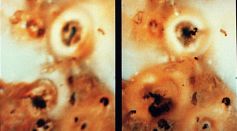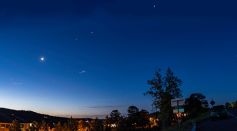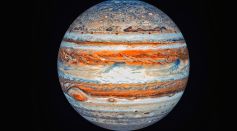Tags: Jupiter

NASA's Juno Mission Unravels Volcanic Mysteries of Jupiter's Moon Io

Parade of Planets: Saturn, Mars, and Jupiter To Align With the Moon in the Predawn Skies This Weekend
Low-Temperature Hydrothermal Vents Could Survive on Ocean Moons Like Jupiter’s Europa, Saturn’s Enceladus and Host Alien Life
NASA’s Juno Probe Captures Lava Lakes Covering Whole Surface of Jupiter’s Moon Io
James Webb Space Telescope Spots Previously Unseen Structure Above Jupiter's Great Red Spot

Infrared Glow on Jupiter’s Night Side Could Be Due to Interaction With Dark Matter, Experts Suggest
Jupiter’s Great Red Spot Revealed by Supercomputer Simulations; Giant Storm May Not Be Quite as Old as First Thought
Jupiter’s Raging Cyclone May Be Similar to Earth’s Ocean [Study]
Venus, Earth and Jupiter May Have Something To Do With the Sun’s Multi-Rhythmic Solar Heartbeat [Study]
NASA Releases High-Definition Photos of Jupiter’s Moon Europa With Complex Surface Features Called ‘The Platypus’

Bizarre Planet 'WASP-193b' Found To Have the Density of Cotton Candy Despite Its Enormous Size, Making It Second-Least Dense Exoplanet Ever Discovered
NASA's Juno Mission Releases New Photos Featuring Great Red Spot, Potato-Like Shape Moon Amalthea
NASA Releases Stunning Concept Art of Lake Lava Loki Patera on Jupiter's Io Moon
NASA’s Juno Discovers Glass-Smooth Lake of Cooling Lava on Surface of Jupiter’s Moon Io
Ice Giants Neptune and Jupiter May Contain Frozen Methane That Explains Their Formation [Study]
Earth’s Violent Ending: Expanding Sun Will Swallow Our Planet in 6 Billion Years, Other Celestial Bodies Could Be Ground Into Dust
Probing Europa: NASA's Instrument Set To Detect Potential Signs of Life on Jupiter's Icy Moon
NASA's Europa Clipper: Enchanting Poetic Tribute and Millions of Names Set to Embark on a Journey to Jupiter's Mysterious Moon
Jupiter’s Blue Spot Has Mysterious Jet That Appears Every 4 Years and Fluctuate Like Waves
Europa's Alien Life Prospects Dwindle: NASA's Juno Mission Reveals Jupiter's Moon Holds Limited Oxygen
Most Popular

Largest Known Volcanic Aquifer Discovered Beneath Oregon's Cascades

New 'Supergiant' Sea Bug Found in South China Sea, Named After Darth Vader

Mediterranean Sea Was Refilled by a Catastrophic Flood Millions of Years Ago

Mysterious Cosmic Waves That Sound Like Birds Detected in Unexpected Space Region





